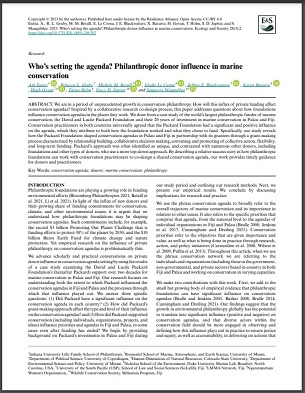
We are in a period of unprecedented growth in conservation philanthropy. How will this influx of private funding affect conservation agendas? Inspired by a collaborative research co-design process, this paper addresses questions about how foundations influence conservation agendas in the places they work. We draw from a case study of the world’s largest philanthropic funder of marine conservation, the David and Lucile Packard Foundation and their 20 years of investment in marine conservation in Palau and Fiji. Conservation practitioners in both countries universally agreed that the Packard Foundation had a significant and positive influence on the agenda, which they attribute to both how the foundation worked and what they chose to fund. Specifically, our study reveals how the Packard Foundation shaped conservation agendas in Palau and Fiji in partnership with its grantees through a grant-making process characterized by relationship building, collaborative decision making, convening and promoting of collective action, flexibility, and long-term funding. Packard’s approach was often identified as unique, and contrasted with numerous other donors, including foundations and other types of donors, who use a more top-down approach. By describing a relative success story in how philanthropic foundations can work with conservation practitioners to co-design a shared conservation agenda, our work provides timely guidance for donors and practitioners.












